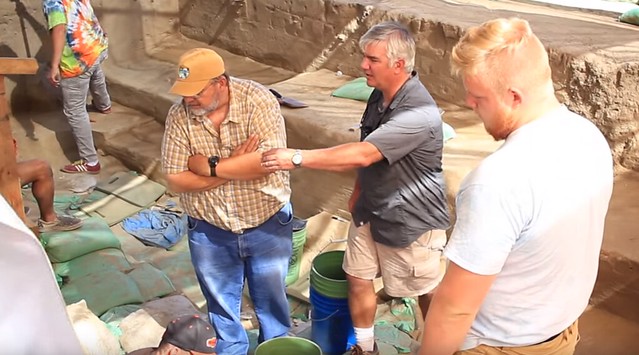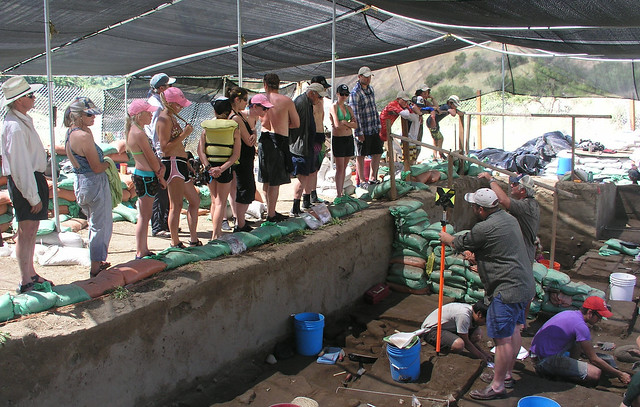New research from Idaho archaeological site could change our understanding of ancient history
Published at | Updated atDiscoveries made at an archaeological Idaho site are challenging the current understanding of how and when ancient people arrived in North America.
Scientists recently published findings in the journal Science theorizing that ancient humans were populating the Pacific Northwest centuries earlier than previously thought. Researchers also hypothesize that the earliest inhabitants of the continent came not by a land bridge between Europe and North America, but by sea from Asia.
RELATED | Idaho artifacts show humans came to North America via a water route, not land
These theories are based upon artifacts unearthed and research done at the Cooper’s Ferry site located in the Salmon River Canyon in western Idaho. Artifacts discovered there include fragments of stone and bone which have been radiocarbon dated to 16,000 years ago.
“We’re looking at, at this point, the oldest radiocarbon find in North or South America,” Bureau of Land Management archaeologist David Sisson told East Idaho News.com.
The site was initially recorded by Idaho State University archaeologist B. Robert Butler in the 1960s.
“He didn’t really have any way to do any radiocarbon dating at that time,” Sisson said. “So he did some excavation and got some artifacts and took them back to ISU and felt that this is one of the more important sites in the Pacific Northwest.”
Sisson and the BLM began collaborating with Loren Davis of Oregon State University on researching Cooper’s Ferry in 1997. Sisson said Davis and OSU helped provide the necessary resources to properly excavate the site.
“I knew Loren had worked here in ‘97,” said Sisson. “This was a complicated project and you’ve got to commit for the long haul. I knew he was willing to do that.”
Early discoveries included a “toolkit” containing projectile tips of other things ancient humans would need to survive.
“Let’s say you’re out and you lose your tools,” Sisson explained. “You knew you could come to this place and get four points that were ready to go. You had raw material and another stone to flake raw material with.”
In 2009, Davis and Sisson returned to Cooper’s Ferry under an agreement with the BLM and began searching for other finds the site might yield. Scientists have found a fire pit, where the soil is compacted and orange, along with stone flakes and bone material. The artifacts radiocarbon dated to around 14,000 years ago.
In the lowest levels of the dig, researchers could not find anything they could get radiocarbon dates from so they turned to Oxford Radiocarbon Lab in England for statistical analysis to help date when the site was first occupied. The lab returned a date of 16,000 years.
“I’d like to say that I totally expected those dates, but I totally did not expect those dates,” Sisson said
Not only did the age of the site surprise Sisson but he was also surprised that artifacts found at the site compared very favorably with artifacts found in Japan. This suggests that early humans entered the area by sea instead of the widely-held belief that humans entered the continent via a now-submerged land bridge between Europe and North America.
“There’s always been ideas that people traveled on the ocean to come around from Northeast Asia down into North America and South America,” said Sisson.
This idea differs from the accepted theory that humans came through an ice-free corridor into Canada then spread out into the Northwest U.S. region. Sisson said the Cooper’s Ferry research tells a different story.
“What we’re seeing with the dates that we got is that ice-free corridor was not ice-free,” Sisson explained. “It was still a block of ice. If you think about a block of ice, you can’t really live off that if you need plants and animals to eat. So, your best alternative is to come down the coast because you’ll have fish and plant life because it won’t be so cold.”
Sisson, Davis and their team believe that ancient people found their way into our area via the Columbia River. Because of ancient megafloods, he believes any sites you’d expect to find along that route to have been washed away. That makes Cooper’s Ferry an even more special and important site, not only for western Idaho but for the entire Pacific Northwest region.
“There aren’t many sites of this age with these kinds of artifacts,” Sisson said. “The information we gather here can be applied all across Idaho or Oregon or Washington or Nevada and California or the far West. It has a lot of importance in that the information we’re gathering is applicable to so many places in the world.”
To learn more about this archaeological site and the work done there, you can check out the Cooper’s Ferry YouTube channel.




